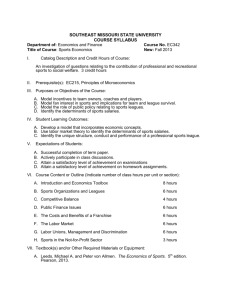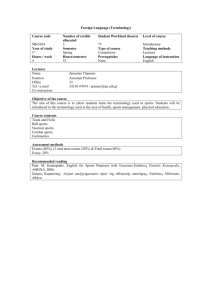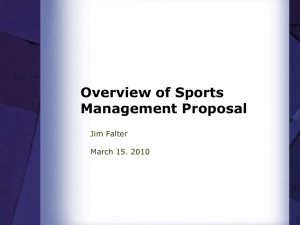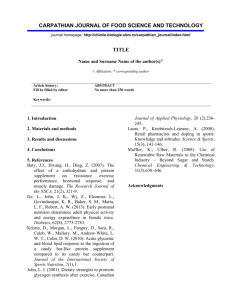Syllabus Sports Economics II (Master Program Economics)
advertisement
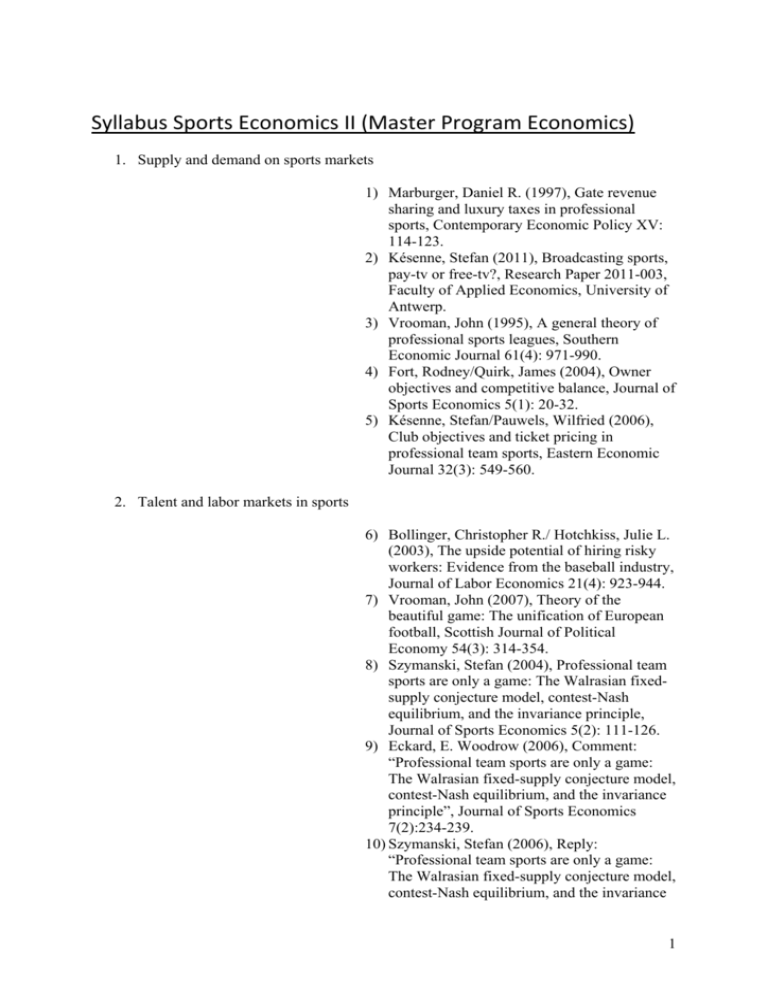
Syllabus Sports Economics II (Master Program Economics) 1. Supply and demand on sports markets 1) Marburger, Daniel R. (1997), Gate revenue sharing and luxury taxes in professional sports, Contemporary Economic Policy XV: 114-123. 2) Késenne, Stefan (2011), Broadcasting sports, pay-tv or free-tv?, Research Paper 2011-003, Faculty of Applied Economics, University of Antwerp. 3) Vrooman, John (1995), A general theory of professional sports leagues, Southern Economic Journal 61(4): 971-990. 4) Fort, Rodney/Quirk, James (2004), Owner objectives and competitive balance, Journal of Sports Economics 5(1): 20-32. 5) Késenne, Stefan/Pauwels, Wilfried (2006), Club objectives and ticket pricing in professional team sports, Eastern Economic Journal 32(3): 549-560. 2. Talent and labor markets in sports 6) Bollinger, Christopher R./ Hotchkiss, Julie L. (2003), The upside potential of hiring risky workers: Evidence from the baseball industry, Journal of Labor Economics 21(4): 923-944. 7) Vrooman, John (2007), Theory of the beautiful game: The unification of European football, Scottish Journal of Political Economy 54(3): 314-354. 8) Szymanski, Stefan (2004), Professional team sports are only a game: The Walrasian fixedsupply conjecture model, contest-Nash equilibrium, and the invariance principle, Journal of Sports Economics 5(2): 111-126. 9) Eckard, E. Woodrow (2006), Comment: “Professional team sports are only a game: The Walrasian fixed-supply conjecture model, contest-Nash equilibrium, and the invariance principle”, Journal of Sports Economics 7(2):234-239. 10) Szymanski, Stefan (2006), Reply: “Professional team sports are only a game: The Walrasian fixed-supply conjecture model, contest-Nash equilibrium, and the invariance 1 principle”, Journal of Sports Economics 7(2): 240-243. 3. Corruption 11) Duggan, Mark/Levitt, Steven D. (2002), Winning isn’t everything: Corruption in Sumo wrestling, American Economic Review 92(5): 1594-1605. 12) Dietl, Helmut M./Lang, Markus/Werner, Stephan (2010), Corruption in professional Sumo: An update on the study of Duggan and Levitt, Journal of Sports Economics 11(4): 383-396. 4. Doping 13) Eber, Nicolas/Thépot, Jacques (1999), Doping in sport and competition design, Recherches Économiques de Louvain 65(4): 435-446. 5. Subsidies 14) Owen, Jeffrey G. (2003), The stadium game: Cities versus teams, Journal o f Sports Economics 4(3): 183-202. 15) Fort, Rodney (2004), Subsidies as incentive mechanisms in sports, Managerial and Decision Economics 25: 95-102. Surveys: 1. Supply and demand on sports markets - Szymanski, Stefan (2003), The economic design of sporting contests, Journal of Economic Literature XLI: 1137-1187. 2. Talent and labor markets in sports 3. Corruption - Maennig, Wolfgang (2005), Corruption in international sports and sport management: Forms, tendencies, extent and countermeasures, European Sport Management Quarterly 5(2): 187-225. 4. Doping - Dilger, Alexander/Frick, Bernd/Tolsdorf, Frank (2007), Are athletes doped? Some theoretical arguments and empirical evidence, Contemporary Economic Policy 25(4): 604615. 5. Subsidies - Baade, Robert A. (2003), Evaluating subsidies for professional sports in the United States and Europe: A public-sector primer, Oxford Review of Economic Policy 19(4): 585-597. 2 Sports Economics II MA Program Questions for discussions 3 4 5 6 7 8 9 10 11 12 13 14 15 16 17



